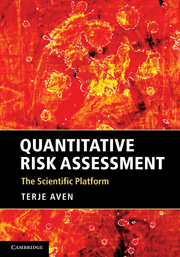Book contents
- Frontmatter
- Contents
- Preface
- Acknowledgments
- 1 Introduction to risk management and risk assessments. Challenges
- 2 Concepts and perspectives on risk
- 3 Science and scientific requirements
- 4 Introduction to case studies
- 5 Risk assessment when the objective is accurate risk estimation
- 6 Risk assessment when the objective is uncertainty descriptions
- 7 Risk management and communication issues
- 8 Towards a holistic scientific approach to risk assessment
- 9 Conclusions
- Appendix A Introduction to probability theory and statistical analysis
- Appendix B Terminology
- References
- Index
Appendix A - Introduction to probability theory and statistical analysis
Published online by Cambridge University Press: 05 June 2012
- Frontmatter
- Contents
- Preface
- Acknowledgments
- 1 Introduction to risk management and risk assessments. Challenges
- 2 Concepts and perspectives on risk
- 3 Science and scientific requirements
- 4 Introduction to case studies
- 5 Risk assessment when the objective is accurate risk estimation
- 6 Risk assessment when the objective is uncertainty descriptions
- 7 Risk management and communication issues
- 8 Towards a holistic scientific approach to risk assessment
- 9 Conclusions
- Appendix A Introduction to probability theory and statistical analysis
- Appendix B Terminology
- References
- Index
Summary
This appendix reviews some elementary probability theory and statistical analysis. The presentation is based on Aven (2003, 2008a).
Probability theory
The meaning of a probability
The probability of an event A, P(A), can be defined in different ways. It is common to distinguish between three types of probabilities, or more precisely, three types of interpretations:
classical probabilities
frequentist probabilities (relative frequency-interpreted probabilities)
subjective (knowledge-based) probabilities.
The classical interpretation applies only in situations with a finite number of outcomes which are equally likely to occur. According to the classical interpretation the probability of A is equal to the ratio between the number of outcomes resulting in A and the total number of outcomes, i.e.
P(A) = Number of outcomes resulting in A/Total number of outcomes.
As an example consider the tossing of a die. Here P(the die shows one) = 1/6 since there are six possible outcomes which are equally likely to appear and only one that gives the outcome 1.
Following the relative frequency interpretation, probability is defined as the fraction of times the event A occurs if the situation considered were repeated (for real or hypothetically) an infinite number of times. Thus, if an experiment is performed n times and the event A occurs nA times, the P(A) is equal to the limit of nA/n as n goes to infinity, i.e. the probability of the event A is the limit of the fraction of the number of times event A occurs when the number of experiments increases to infinity.
- Type
- Chapter
- Information
- Quantitative Risk AssessmentThe Scientific Platform, pp. 178 - 196Publisher: Cambridge University PressPrint publication year: 2011



